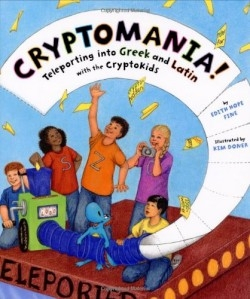Cryptomania
Teleporting into Greek and Latin With the Cryptokids
Fantasy and fact collide in this elaborate tale of five classmates, each with a name connected to Greek or Latin, who embark on a series of journeys. Because of their ability to decode difficult words and simultaneously solve mysteries, Cassi, Marcus, Stella, Zander, and Theo have dubbed themselves the Cryptokids. Though perplexed by their first mission, they build Zander’s teleporter (tele = far and port = carry) with anticipation.
They have a huge Mega-Word Opus assignment to complete and a centennial celebration to plan for, but they still manage to time-travel to exciting places such as Ancient Greece and Rome, prehistoric eras, and the lesser-known Mathopolis, as they attempt to help their new friend Alphy, a blue dinosaur, return home. Wherever the kids travel, they become a part of the landscape. For instance, while visiting prehistoric times, they dress like Fred Flintstone and become students at the Alphasaurus Academy.
Nonlinear in format, this book reads like digital media, with hypertext packaged like traditional literature. In addition to the main story are lists of “word chunks” and their Latin or Greek derivatives, along with sidebars filled with factual information about people, places, and concepts.
The cluttered format might make the book difficult for readers who fancy a more traditional, linear layout, but for those who enjoy a more postmodern read, the interactive design allows readers to pick and choose which information they wish to take in and the order in which they wish to read it. Should readers continue with the storyline or pause to read the sideline remarks, jokes, and riddles made by a squirrel and a blue jay? Or should they jump to the bottom of the page, where an image of Zander appears followed by a summary of the action in the double-page spread? It is up to the reader to decide, and the variety may provide motivation for subsequent perusals.
Using varied font style and size, as well as rich, bright colors, and balloons to convey dialogue, the representational illustrations help merge the worlds of fantasy and realism and are partly responsible for the hypertext look of the book. The illustrator has previously provided art for Buffalo Dreams, Q is for Quark, and The Philosophers’ Club. Here, her depictions of signs on buildings and walls and the information and facts in white boxes all add an additional layer of enrichment to the story.
The author has written twelve previous children’s books, including the recently published Rosa Parks: Meet a Civil Rights Leader and the popular Nitty-Gritty Grammar and More Nitty-Gritty Grammar, which she co-authored with Judith Josephson. She has put years of experience teaching Greek and Latin word parts to elementary school children to good use in this multi-layered, exciting picture book.
Reviewed by
Kaavonia Hinton
Disclosure: This article is not an endorsement, but a review. The publisher of this book provided free copies of the book to have their book reviewed by a professional reviewer. No fee was paid by the publisher for this review. Foreword Reviews only recommends books that we love. Foreword Magazine, Inc. is disclosing this in accordance with the Federal Trade Commission’s 16 CFR, Part 255.

